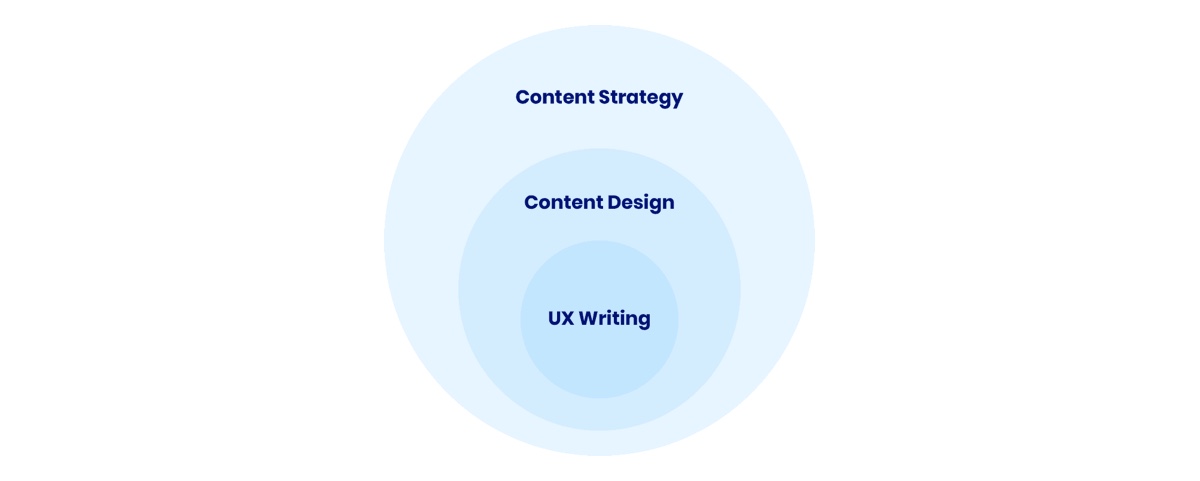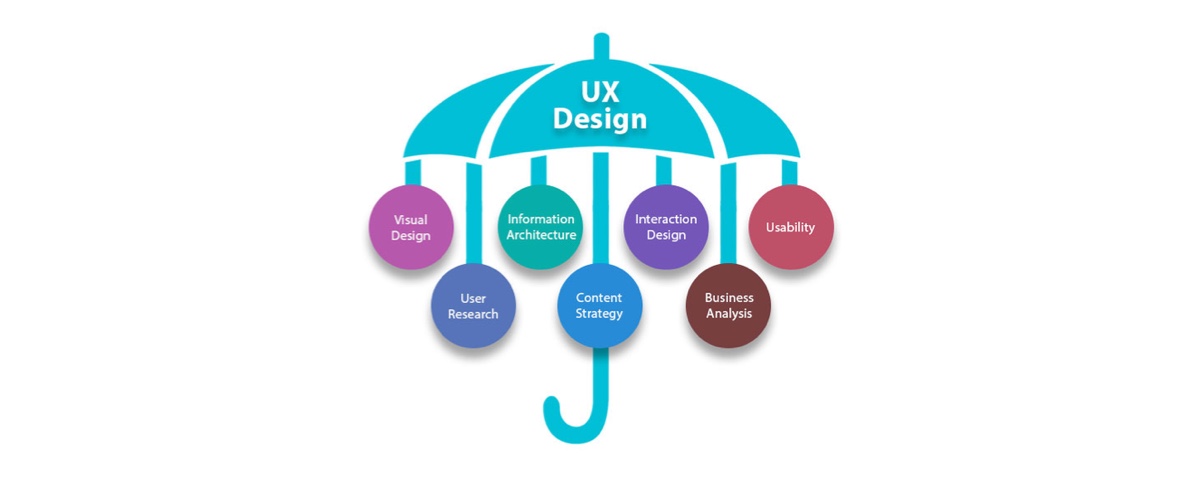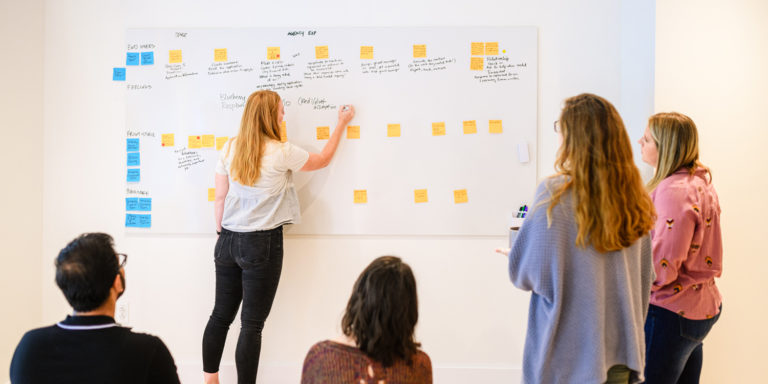For those who are new to digital content strategy, the myriad ways a content strategist provides value to digital websites and products can be surprising. One of the first surprises is the very definition of “content”: content is any written or visual piece of information that comes from your organization. Most organizations have a plan when it comes to marketing a product or service, but many are surprised when asked what the strategy is for information given to their customer support team. A useful content strategy is a blend of business needs and user needs—do you really know who your users are? Are you sure your content is meeting their needs?

Image: Writer.com
While some firms may view content strategy as an extension of the brand or social media marketing, we see it as a foundational aspect of a modern approach to user experience design, akin to research or design systems. To that end, we’ve compiled a list of resources and advice that will provide a deeper look into this world, whether you are unfamiliar with digital content strategy, trying to break into the business, or simply want to expand your content strategy skills and knowledge. We’ve previously shared some outstanding content in our blog post, Career Tips & Resources for Aspiring UI/UX Designers, so we’ll minimize overlap in this article wherever possible.

Image: RubyGarage, Medium.com
In this post we’ll cover:
- 📚 Content strategy resources
- 🛠 Tools of the trade
- 💬 Career tips + advice
📚 Content strategy resources
🤓 Communities for content strategists
There are many communities for content strategists and aspiring content strategists to grow and share their craft. Consider joining an online community, attending a local event, or visiting a conference.
- Button. Button is the conference for content design. Check out their Equity Scholarship program for those who are marginalized due to systemic oppression and exclusion.
- Confab Events. An annual conference about “all things content.”
- Content + UX. A slack community full of folks discussing content strategy, user experience, and how they interact. One of the big perks of this group is the job posting feature—all jobs must have salary information in the posting.
- Design and Content Conference. The Design and Content Conference focuses on the intersection of content strategy and UX design.
- IAC: The Information Architecture Conference. The IAC is a large conference on information architecture, UX design, and content strategy.
- World IA Day. World Information Architecture Day is an annual event that takes place in various places around the world, all dedicated to one IA-related theme chosen each year.
- Ladies Who Strategize. A slack community of female-identifying and non-binary strategists. The group is utilized as a resource for advice, tools, research, ideas and collaboration. They host online and in-person gatherings and events on a regular basis.
- LavaCon. LavaCon is a conference that changes locations each year, and has a particular focus on the tools and technology (e.g., CMSs, or content management systems, and DITA, or Darwin Information Typing Architecture) used in content strategy.
- Meetup.com. This platform is used to organize online groups that host in-person and virtual events for people with similar interests. Consider joining a few content strategy groups or create your own. Many of our Thinkers are members of Philly Content Strategy.
- UtterlyContent. An online conference for content strategists, content marketers, content designers, and UX professionals.
🧠 Learn & grow
Looking to upskill quickly or grow incrementally? Consider taking advantage of the multitude of courses, lectures, podcasts, and thought leaders out there.
- A List Apart. Run by the A Book Apart publishers (you’ll notice several of their books make our book list below), this is a huge repository of useful articles.
- Adventures in Content Strategy. A blog about making healthcare and healthy living accessible.
- Autogram. Three content strategy leading experts founded Autogram, and their thoughts and resource list are valuable reading.
- Brain Traffic. Resources from the folks who wrote Content Strategy for the Web (head to the books section to learn more about this resource).
- Content Strategy Insights Podcast. Conversations with a range of content strategists from different fields, including UX and SEO.
- Contentful. White papers, webinars, videos and industry reports on enterprise content management and digital product delivery.
- Eating Elephant. A blog about content strategy and information architecture, with a focus on user needs.
- Facilitator’s Q&A with Jay. A bi-weekly video series to help facilitators lead team conversations that are “trusting, powerful, and engaging.”
- Gamestorming. A set of tools and activities for design thinking, visual thinking, and innovation.
- GatherContent. This site has downloadable templates to use and hosts useful webinars with real-life applications.
- Lullabot. This company’s site has articles and webinars on content strategy, design, Drupal development, and more.
- Nielsen Norman Group Content Strategy Courses. An industry leader, their global UX conferences include courses on various content strategy topics, with certifications available.
- The Content Strategy Experts – Scriptorium Podcast. A content strategy blog and podcast episodes with transcripts.
- The Content Strategy Podcast. A podcast “for people who care about all things content.”
- UX Foundations: Content Strategy. LinkedIn Learning’s course on content strategy.
- Voice, Tone & Content Guides. Find voice, tone, and style guides from exceptional content teams for recognizable brands.
📰 Essential content strategy articles
Quick hits to get the intellectual juices flowing.
- Collaboration is king: How teaching your teammates will boost your impact, Gene Shannon
- Complete Beginner’s Guide to Content Strategy, uxbooth.com
- Content Modeling Series, Cleve Gibbon
- Content strategy 101, Intuit
- Content strategy: blending art, science, personalization, and technology, Writer.com
- How to Build a User-Centric Information Architecture Without Endless Debate, Paul Boag
- New Thinking: Brain Traffic’s Content Strategy Quad, Kristina Halvorson
- Revisiting Plain Language, plainlanguage.gov
- The Discipline of Content Strategy, Kristina Halvorson
- Tone of Voice and User Experience, Seda Manucharyan
- What is a content audit anyway?, Roy Fisher and Isabelle Sperano
- Understanding content strategy—the basics, Khawar Latif Khan
- UX writing, UX copywriting, content strategy, and content design are not the same job, Blanca Rego (@lauxcritora)
- What’s the role of content management in digital products?, Michael Andrews
📖 Books
Books may be the most common way to gain education about the field and the emerging areas of content strategy. Below are the books we’d recommend you put on your reading list to learn from the experts and increase your knowledge.
- Content Design, Sarah Richards. A quick, introductory guide to content design.
- Content Everywhere: Strategy and Structure for Future-Ready Content, Sara Wachter-Boettcher. This book will help you make content “more future-ready, flexible, reusable, manageable, and meaningful.”
- Content Strategy at Work, Margot Bloomstein. A book for “anyone who works with visual or verbal content.”
- Content Strategy for Mobile, Karen McGrane. A concise reminder that the user decides the platform or device they use to access content, and how to strategize for this.
- Content Strategy for the Web, Kristina Halvorson and Melissa Rach. This foundational book describes the value of content strategy, how to audit and analyze content, and ways to maintain content over time.
- Conversational Design, Erika Hall. An explanation on how to make digital systems “feel less robotic and more real.”
- Designing Connected Content: Plan and Model Digital Products for Today and Tomorrow, Carrie Hane and Mike Atherton. A process-based account of content strategy, content design, and content management.
- Everyday Information Architecture, Karen McGrane. This book goes over how to “analyze your site’s content and structure, build clear and consistent taxonomies, and develop more strategic sitemaps.”
- How to Make Sense of Any Mess: Information Architecture for Everybody, Abby Covert. This book provides a generalized process for making sense of any mess, with a set of lessons and workbook exercises.
- Lead with Content: How to Put Content at the Centre of Digital Transformation, Padma Gillen. A resource to help organizations think about user needs, workflow and governance, and more.
- Managing Chaos: Digital Governance by Design, Lisa Welchman. Focuses on digital governance and “its transformative power to support creativity, real collaboration, digital quality, and online growth.”
- Managing Enterprise Content: A Unified Content Strategy, Ann Rockley and Charles Cooper. A repeatable plan for an overarching enterprise content strategy.
- Nicely Said, Nicole Fenton and Kate Kiefer Lee. An easily digestible guide to writing clear and friendly content.
- The Accidental Taxonomist, Heather Hedden. A (very) comprehensive guide about building information taxonomies.
- The Content Strategy Toolkit: Methods, Guidelines, and Templates for Getting Content Right, Meghan Casey. A step-by-step approach for doing content strategy, from planning and creating your content to delivering and managing it.
- The Elements of Content Strategy, Erin Kissane. A concise guide on the origins of content strategy.
- The Language of Content Strategy, Rahel Anne Bailie and Scott Abel. This book defines core concepts and terminology for content strategy.
- Why You Need a Content Team and How to Build One, Rachel McConnell. Develop an understanding of your content maturity and how to increase it. This book explains the different content roles, including how they overlap.
📩 Newsletters
Stay up-to-date on the latest and sign up for a dose of content strategy (and content-adjacent topics) straight to your inbox.
- Accessibility Weekly. A weekly newsletter on web accessibility.
- Brain Traffic. Content strategy resources and announcements of workshops and events.
- GatherContent. Weekly content strategy advice and events.
- HeyDesigner. Newsletter for product people, UXers, PMs, and design engineers.
- UX Writing Events. A newsletter specifically for UX writing events.
- Working in Content. A once a week-ish newsletter with expert interviews, resources, and job opportunities.
🛠 Tools of the trade
The following are some of the tools we currently use and love. We are firm believers in using the right tool for the job, so use what works for you (and your client or company). While you don’t need to master all of the tools listed, it’s a good idea to have general knowledge about what they are and why they exist.
🎨 Whiteboarding and workshopping
- FigJam. Whiteboarding tool from the makers of Figma.
- Miro. Online whiteboarding tool, with lots of features and templates—a fan favorite!
- MURAL. Another online whiteboarding tool, with great collaboration features.
⛑ Content organization and planning
- Airtable / Google Sheets / Excel. From organizing a content inventory to creating a content model, spreadsheets are a content strategist’s best friend. Check out our blog post on how to use Airtable for content audits.
- Google Docs / MS Word. Don’t underestimate the value of a good text editor! These tools can be used for a variety of use cases but when it comes to content, we use them to build page tables, create voice & tone guidelines, and share documentation among teams.
- Notion / Basecamp / Confluence. Too many tools? Too much chaos? Consider gathering all of your work in one place. Depending on the project, company, or client we will keep a single source of truth to track all documentation and decision making along the process.
- Trello. If you are feeling overwhelmed, or have a proclivity for “to-do” lists, consider a kanban board to track progress and stay on top of deadlines.
💻 Content Management System (CMS)
- Contentful. “More than a headless CMS.” Users can create, manage, and publish content to digital channels through this API-first content management platform.
- Craft CMS. “Craft is a flexible, user-friendly CMS” used to create custom digital experiences on the web.
- Drupal. A free and open-source web-based content management system. Drupal provides a back-end framework for at least 13% of the top 10,000 websites worldwide. Whether it’s a personal blog, corporate website, or political\government site—Drupal can handle it all.
- Kontent. “Kontent is a headless CMS that offers easy-to-use content management tools for marketers.” A great tool that allows you to free up developers so they can put their focus elsewhere.
- Sharepoint. SharePoint is a tool from our friends at Microsoft. It allows users to collaborate on documents and build structure with visual layouts. While it’s not our favorite, many large organizations have access to Microsoft Suite and for many teams this is their best (or only) option.
- WordPress. “WordPress is a free and open-source content management system written in PHP and paired with a MySQL or MariaDB database.” It features plugin architecture and a template system that helps streamline your content creation.
Check out our guide to Choosing the Right CMS for Your Business.
📐 Content measurement and validation
- Google Analytics. Google Analytics, a web analytics service offered by Google that tracks and reports website traffic. It is worth keeping in mind that, in UX terms, metrics measure the “what,” and not necessarily the “why” of user behavior, and metrics should be coupled with a generous helping of user testing/talking to actual users.
- Google Data Studio course. Google offers free training for Google Data Studio, a widely used reporting dashboard that works in tandem with Google Analytics (see above).
- Google Optimize. Google Optimize offers A/B testing, website testing & personalization tools for small businesses to help deliver engaging customer experiences—it is a great free tool for those starting out with A/B testing.
- Hotjar. Hotjar is an intuitive, visual way to discover, consolidate, and communicate user needs. You can use its heatmaps, recordings, surveys, and feedback to empathize with and understand your customers.
- Real Eye. Real Eye allows you to perform eye-tracking with just a webcam.
- Screaming Frog SEO Spider. The Screaming Frog SEO Spider is a website crawler that helps improve SEO; it is also a tool used often by content strategists as the base for a content inventory.
- UXMetrics. “Free tools to research and optimize any information architecture.”
🌱 Career tips and advice
There are about 376,000,000 results when googling “career advice for content strategist”—but as you will hear from our team, there are different types of strategists and we all took a winding path to get where we are. Generally, you will see commonalities in our strategy team when it comes to cross-discipline collaboration and systems-based thinking. Content strategist isn’t a one size fits all job description which is why we focus so much on the type of content strategy we do here.
On careers in content strategy
“My path into Content Strategy was very organic, driven by my curiosity to understand how and why some content works and other content doesn’t. Having an opinion and the means to articulate that opinion helps.” – Amanda Ditzler, Senior Content Strategist
“Many of us were already doing ‘content strategy’ before we even knew what it was called. That’s a common refrain I hear from colleagues and peers. When you start diving into content strategy books and resources, you may realize that you too are already doing a lot of this work, and you can continue to add new approaches and methodologies to what you’re doing that will heighten your impact.” – Britt Brouse, Senior Content Strategist
“I got here by doing more of the type of work I wanted to do and less of the work I didn’t. With my last employer, I hit a tipping point where I had the opportunity to have a direct conversation with leadership. I said that I was at capacity and that I could either do the job they hired me for or I could do all of the other stuff—but that I couldn’t do both. I had built a lot of trust and was given an intern to start and then built a whole team. I dove headfirst into content strategy and never looked back.” – Jaydee Devine, Senior Content Strategist
“It was a winding road. After a 5-year career as an English high school teacher and raising 3 sons, I wanted to become a writer. I took some courses in copywriting, including copywriting for the web. At that time, my hairstylist was opening a new salon and I helped build the website for her new business. I ended up taking a crash course in WordPress, PhotoShop and SEO and was doing information architecture without even knowing what that was.” – Debbie Wright, Senior Content Strategist
“How the heck did I get here?” – Regina Lam, Principal Content Strategist
On evolving your practice
“I find books on content strategy, especially those deemed as foundational, extremely thorough and applicable to our work.” – Regina Lam, Principal Content Strategist
“Ask questions. Don’t be afraid to say, “I don’t know, but I’ll find out.” Accept challenges outside of your comfort zone. The more you try new things, the more you’ll learn naturally.” – Amanda Ditzler, Senior Content Strategist
“All you really need to get started or evolve your content strategy practice is curiosity and the willingness to learn from the solid approaches and advice available from within the community.” – Britt Brouse, Senior Content Strategist
On overcoming obstacles
“You’ll often hear advice about knowing when to ask for help, but it’s just as important to know what kind of help to ask for. Whether I’m facing a task I’ve never done before or struggling with the best way to present my recommendations to a stakeholder, I evaluate the situation to identify the part I’m struggling with. Sometimes, the hardest part is just getting started, and other times I need more detailed advice. Whatever help I need, being able to identify the challenge enables me to seek out the people who are best prepared to help me in the most effective way.” – Amanda Ditzler, Senior Content Strategist
“If you approach an obstacle with the mindset that every problem can be solved, it gives your creativity as a content strategist the opportunity to shine. Content Strategy is way more than just organizing content or putting eloquent words on a page, it’s about using content to solve problems.” – Ginny Ellsworth, Principal Content Strategist
On collaborating with others
“Listen to people. Understand that everyone has something valuable to bring to the table. Celebrate small wins. Give recognition freely.” – Amanda Ditzler, Senior Content Strategist
“I view my role as someone who solves problems. I’ve found delight in kicking off new relationships by asking “what’s something that really frustrates you about x” and then working with them to make the pain point less painful. I can’t always solve the problem, but listening empathetically is often enough.” – Jaydee Devine, Senior Content Strategist
“When I collaborate with others, whether other Content Strategists or other disciplines, I ALWAYS learn something new. I walk away from every collaboration experience, either with a new skill or able to speak with more authority on a topic that may have been unfamiliar before. Show up with a beginner’s mind, and you can’t go wrong.” – Ginny Ellsworth, Principal Content Strategist
On evolving your career
“I’m a strong believer in building the career that’s right for you. Look for ways to adapt current and future positions into your passions, whether that’s executing on content strategy deliverables, mentoring others, building relationships with stakeholders, or selling content strategy work. If the job doesn’t exist today, seek out the person that will help you create it.” – Chris Coughlan, Principal Content Strategist
“I’m sure you’ve heard the old adage ‘dress for the job you want, not the job you have.’ A bit of practical advice here: that game will only get you so far, be deliberate about communicating your needs, hopes, expectations, and anxieties with the appropriate channels and be open to input.” – Jaydee Devine, Senior Content Strategist
On what we look for in candidates
“When it comes to CS candidates, we are always looking for folks who have the ability to think in terms of systems. Someone who naturally interprets, organizes, connects, and categorizes the world around them makes for a fantastic content strategist.” – Theresa Decker, Manager, Design
“We’re always looking for best-in-class strategists and designers at Think, but the quality that really stands out when we want to bring someone onto our team is curiosity. Do you look at the world around you and want to know more? Can you acknowledge your own gaps and open up to learning, growing, and evolving?” – Abby DePrimo, Vice President, Design
“Landing a job at Think goes beyond technical skills. Understanding how to communicate findings and providing applicable rationale for your recommendations rounds out your skillset. Don’t force the hiring manager to make assumptions—connect the dots for them.” – Chris Coughlan, Principal Content Strategist
“It’s always a treat when the candidate I speak to takes the time to check our website and our work. When they do, it’s easier for them to bring up examples of their projects or experiences that are related to the type of work we do.” – CJ Sitson, Recruiting Coordinator
Finding your way in the content strategy field
Content strategy, like UX, is often not a planned destination for professionals, and most of us accidentally end up in the field. If you work on digital products and websites there’s a good chance you are already “doing” content strategy without even realizing it. Our hope is that you can use these resources to solidify your knowledge base and better define your own journey in the field of digital content strategy.



